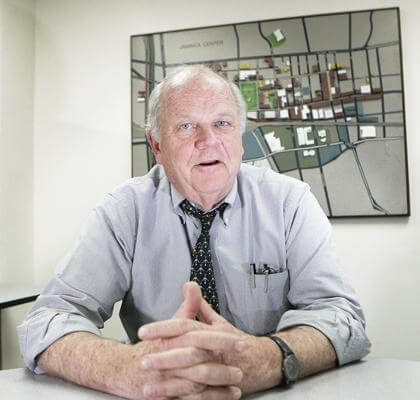By Ivan Pereira
For decades, Carlisle Towery used to view Jamaica as a diamond in the rough in terms of urban growth, but it has now become a striking example of how a downtown on the brink can be rescued and rehabilitated.
As president of the nonprofit Greater Jamaica Development Corp., he has helped to bring the downtown area of the neighborhood out of the commercial crisis it faced in the 1960s and ’70’s by promoting new services, businesses and infrastructure plans that have turned the community into a vibrant area.
The change was not easy, according to Towery, but as an urban planner, he knows that patience and hard work yield good results.
“We fill in the gaps with the community,” he said of Greater Jamaica. “If a project happens, it happens with strong community support and help from other sources.”
Born and raised in Alabama, Towery attended the liberal private school Indian Springs School during the mid−1950s when the South was still dealing with racial segregation. He recalled that just being part of the graduating class, which included two black students, was considered a bold move in his neighborhood.
“The school was in Shelby County, which was at that time KKK territory,” he said.
Towery later earned a bachelor’s in architecture from Auburn University in Alabama and then a master’s in architecture and planning from Columbia University. After graduating, he was hired by the nonprofit organization Regional Plan Association, which helps build infrastructure and community design for the tri−state area, to work on improving Jamaica.
When he first visited the neighborhood in 1964, Towery said the community had lost a lot of the commercial spark it had in the 1920s, since businesses and shoppers were moving to the regional malls in other parts of the city and Nassau County. Towery and his team, which would become the Greater Jamaica Development Corp. in 1967, decided to combat the commercial flight by promoting a new centralized Jamaica.
“We said you should organize services like jobs, courts and colleges in the area,” Towery recalled. “RPA looked at the place and said its leaders needed … an entity with a long−term view.”
Using this mantra, Greater Jamaica called on the city and state to bring York College to the Jamaica area because it would change the demographic of the community’s visitors. Its location near the Archer Avenue bus depot, Archer Avenue subway station and Long Island Rail Road made it easily accessible by students across the city.
“We wanted to make York the new centerpiece,” he said.
In 1968, after some long talks with city leaders, CUNY agreed to set up the school’s campus in Jamaica. York, which moved to Jamaica in 1971 from temporary quarters in Bayside, now has become one of the borough’s leading colleges.
But Towery and Greater Jamaica did not stop there. Over the last four decades, his organization has helped facilitate the creation of several notable downtown Jamaica shops as well as services, including the Food and Drug Administration’s building on the York Campus, the Jamaica Center for Arts and Learning and the ongoing Sutphin Underpass project, which will bring retail stores to the area underneath the AirTrain station.
Towery said each one of his organization’s accomplishments was designed to benefit Jamaica’s residents after extensive consultations with the community and the civic organizations.
“So much of planning ends up being about demographics,” he said. “A lot of developers don’t know who they are planning for. In a case like [Jamaica], it’s important that you know who you are planning for.”
He said he was grateful to be honored with a TimesLedger Community Impact Award, particularly since he was put in the same league as other Queens leaders, such as York College President Marcia Keizs and Borough President Helen Marshall..
“I’m flattered and honored to be in such good company,” he said.
Reach reporter Ivan Pereira by e−mail at ipereira@timesledger.com or by phone at 718−229−0300, Ext. 146.




































